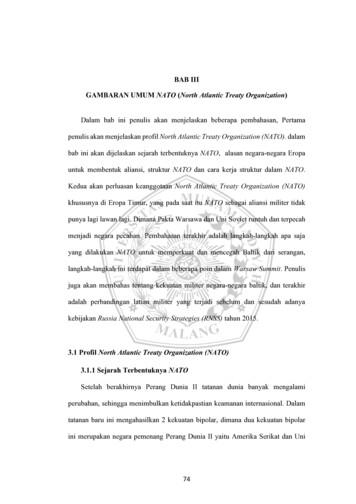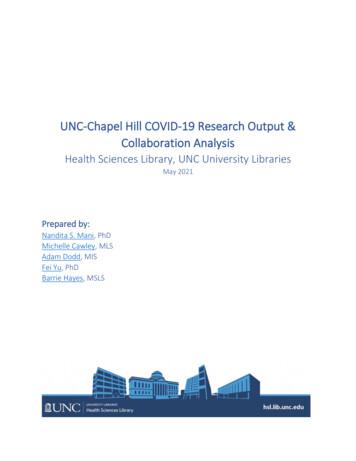Post Cold War NATO - UNC Center For European Studies
Power Point accompaniment for the Consortium’s lessonNATO: Post Cold War-To view this PDF as a projectable presentation, save the file, click “View” in the top menubar of the file, and select “Full Screen Mode”-To request an editable PPT version of this presentation, send a request to cnorris@unc.edu
What is an alliance? What is the purpose of an alliance? What are some examples of alliances?
Cold War The Cold War was a period of East-Westcompetition, tension, and conflict short of fullscale war, characterized by mutual perceptions ofhostile intention between military-politicalalliances or blocs. There were real wars, sometimes called "proxywars" because they were fought by Soviet alliesrather than the USSR itself -- along withcompetition for influence in the Third World, anda major superpower arms race.
US v USSRUnited States & Allies Capitalist, market-basedeconomy Democratic republic Open societyUSSR & Allies Communist, statecontrolled economy Dictatorship Closed society
The Cold War Began in 1945, withdisagreements overthe future of postWWII Europe.– Yalta Conference Ended in 1991, withthe collapse of theSoviet Union.
NATO Charter Read the NATO Charter aloud and answerthe attached questions as a group.
NATO Formed as a defense alliance against the Soviet Union– If one member is attacked, all the others are expected torespond. The Soviet Union responded with the Warsaw Pact Additional countries were added to NATO in 1952,1955, 1982
OriginalMembers BelgiumNetherlandsLuxembourgFranceUnited KingdomUnited StatesPortugalItalyNorwayDenmarkIcelandMembers AddedDuring the Cold War 1952– Greece & Turkey 1955– West Germany 1982– Spain
Major Cold War Events Berlin Airlift (1948 – 49) Second Red Scare &McCarthyism in the US(1947 – 57) China becomescommunist (1949) Korean War (1951 – 53) Berlin Wall (1961 – 89) Cuban Missile Crisis(1962) Vietnam War (1955 –75) Cuba becomescommunist (1961 – 62) Soviet Invasion ofAfghanistan (1979 – 89)
NATO During the Cold War NATO Secretary General, Lord Ismay, oncesaid: “[the purpose of NATO is] to keepthe Russians out, the Americans in, and theGermans down”. Since there was never a full scale outbreakof hostilities between the US and USSRduring the Cold War, NATO was never calledinto action.
Post Cold War NATO The end of the Cold War and the dissolution ofthe Warsaw Pact in 1991 removed the defacto main adversary of NATO. This caused a strategic re-evaluation of NATO'spurpose, nature and tasks. In practice this ended up entailing a gradual(and still ongoing) expansion of NATO toEastern Europe, as well as the extension of itsactivities to areas that had not formerly beenNATO concerns.
NATO Members Post-Cold War 1999o CzechRepublico Hungaryo Poland ovakiaSlovenia 2009o Albaniao Croatia
Post Cold War NATO Conflict remained in the world, despite thecollapse of the Soviet Union. How would NATO respond?
Cold War The Cold War was a period of East-West competition, tension, and conflict short of full-scale war, characterized by mutual perceptions of hostile intention between military-political alliances or blocs. There were real wars, sometimes called "proxy wars" because they were fought by Soviet allies
About the Cold War Museum Founded in 1996 by Francis Gary Powers, Jr. and John C. Welch, the Cold War Museum is dedicated to preserving Cold War history and honoring Cold War Veterans. For more information: Cold War Museum, P.O. Box 178, Fairfax, VA 22030 Ph: 703-273-2381 Cold War Times Sept / Oct 2002: Page 2 On the Cover:
UNC C UNC CH UNC G UNC GA UNC P UNC SA WCU WSSU UNC W-45% -35% -25% -15% -5% 5% 15% 25% 35% 45% Millions Btu/gsf greater than target with use decreasing Btu/gsf greater than target with use INCREASING Btu/gsf less than target with use decreasing Btu/gsf less than target with use increasing kWH 46.0% NG 15.6% 2Oil 2.5% 6Oil 0.6% Propane 0.2 .
Cold War, academic debates on the origins and characteristics of the Cold War have dominated the field of contemporary history. As the Cold War proceeded, the histori-ography of the Cold War developed its own dynamics. In the early phases of the Cold War academic discourse was ideologically partisan, fiercely divergent and even combat- ive. Indeed historians and their works were part of the .
NORTH ATLANTIC TREATY ORGANIZATION (NATO) NATO STANDARDIZATION OFFICE (NSO) NATO LETTER OF PROMULGATION 4 October 2019 1. The enclosed Allied Quality Assurance Publication AQAP-2070, Edition B, Version 4 NATO MUTUAL GOVERNMENT QUALITY ASSURANCE (GQA), which has been approved by the nations in AC/327, is promulgated herewith.
NCS is comprised of US National Stock Numbers and NATO Stock Numbers NATO codification is based on U.S. Federal Catalog System Currently there are more than 18 million NSNs NATO-wide Used by 62 nations around the world, including 28 NATO countries (to find a list of the 28 NATO participating countries please follow)
74 BAB III GAMBARAN UMUM NATO (North Atlantic Treaty Organization) Dalam bab ini penulis akan menjelaskan beberapa pembahasan, Pertama penulis akan menjelaskan profil North Atlantic Treaty Organization (NATO). dalam bab ini akan dijelaskan sejarah terbentuknya NATO, alasan negara-negara Eropa untuk membentuk aliansi, struktur NATO dan cara kerja struktur dalam NATO.
School of Medicine, Gillings School of Global Public Health, UNC Medical Center, or other relevant UNC-CH affiliations (the search strategy is available at: https://go.unc.edu/UNC- . Marsico Lung Institute UNC Hussman School of Journalism and Media NC Translational and Clinical Sciences
The classical approach to public administration, derived from Weber, Wilson and Taylor, largely . Classical and Modern Approaches to Public Administration * Polya Katsamunska is a Ph.D., associate professor at the Public Administration and Regional Development of UNWE, e-mail: polya_katsamunska@yahoo.com. 75 Articles is really impressive and yet "almost no national government would argue .























